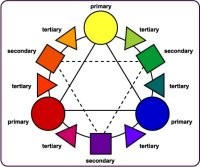The question of “What Is The Colour Of Indigo?” often sparks debate. While Sir Isaac Newton famously identified indigo as one of the seven colours of the rainbow, alongside red, orange, yellow, green, blue, and violet, its distinctness is frequently challenged. Some argue that only six colours are truly discernible in the visible spectrum. This article delves into the nature of indigo, examining its place in colour theory, the physics of light, and the human perception of colour.
The original inclusion of indigo is attributed to Newton’s desire to align the rainbow with the seven notes of the musical scale. However, the “Get Indigo out of the rainbow” Facebook group reflects a common sentiment: that indigo isn’t easily distinguishable and perhaps doesn’t deserve its place.
 Color Wheel Showing Primary, Secondary, and Tertiary Colors
Color Wheel Showing Primary, Secondary, and Tertiary Colors
Indigo and Colour Theory: Additive vs. Subtractive
One argument against indigo’s inclusion is based on the traditional painter’s colour wheel, which identifies red, yellow, and blue as primary colours, and orange, green, and violet as secondary. Indigo doesn’t neatly fit into this scheme, leading some to label it as a tertiary colour and therefore less fundamental.
However, this argument overlooks the crucial distinction between additive and subtractive colour mixing.
Additive Colour Mixing: Light and Primaries
Additive colour mixing, relevant to light, uses red, green, and blue (RGB) as primary colours. When these colours are combined in equal proportions, they produce white light. The secondary colours in this system are cyan, magenta, and yellow. Notably, orange is absent, yet the visible spectrum deals with emitted light, making the additive system more relevant.
Subtractive Colour Mixing: Pigments and Primaries
Subtractive colour mixing, used in pigments and dyes, relies on cyan, magenta, and yellow (CMY) as primary colours. These colours absorb certain wavelengths of light and reflect others. The secondary colours in this system are red, green, and blue. The artist’s colour wheel, with red, blue, and yellow as primaries, is a variation of the subtractive model.
What Indigo Looks Like: A Phenomenological Observation
Ultimately, the perception of indigo as a distinct colour is a subjective experience. Indigo sits on the spectrum between blue and violet. Many find it difficult to differentiate indigo from violet, seeing a continuous gradient rather than a sharp boundary. Indigo is often described as a deep, dark blue tending towards purple.
The exact wavelength of light corresponding to indigo is generally defined as between 420 and 450 nanometers. This places it firmly within the blue-violet portion of the electromagnetic spectrum.
The Spectrum: A Continuous Range
The really interesting question is why we perceive discrete colour bands in the spectrum when the wavelengths vary smoothly and continuously.
Conclusion: Perception and the Colour Spectrum
Whether indigo is a distinct colour is a matter of perception and definition. While some see it clearly, others find it indistinguishable from blue or violet. Regardless of individual perception, the debate highlights the fascinating interplay between physics, biology, and human experience in shaping our understanding of colour. The human eye and brain interpret the continuous spectrum of light and create distinct categories, influenced by language, culture, and individual differences in visual perception. Ultimately, the question of “what is the colour of indigo?” may not have a definitive answer, but it encourages a deeper exploration of the nature of colour itself.
